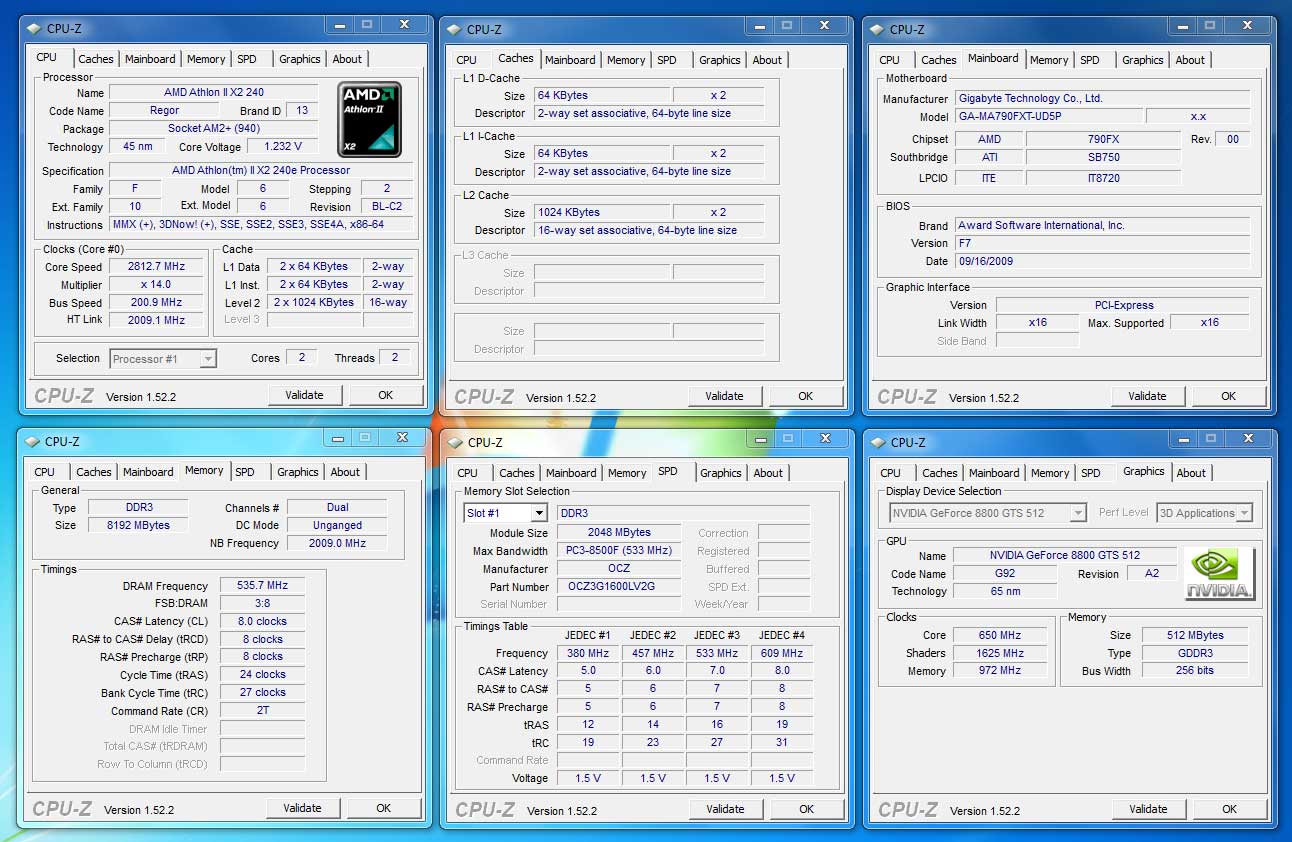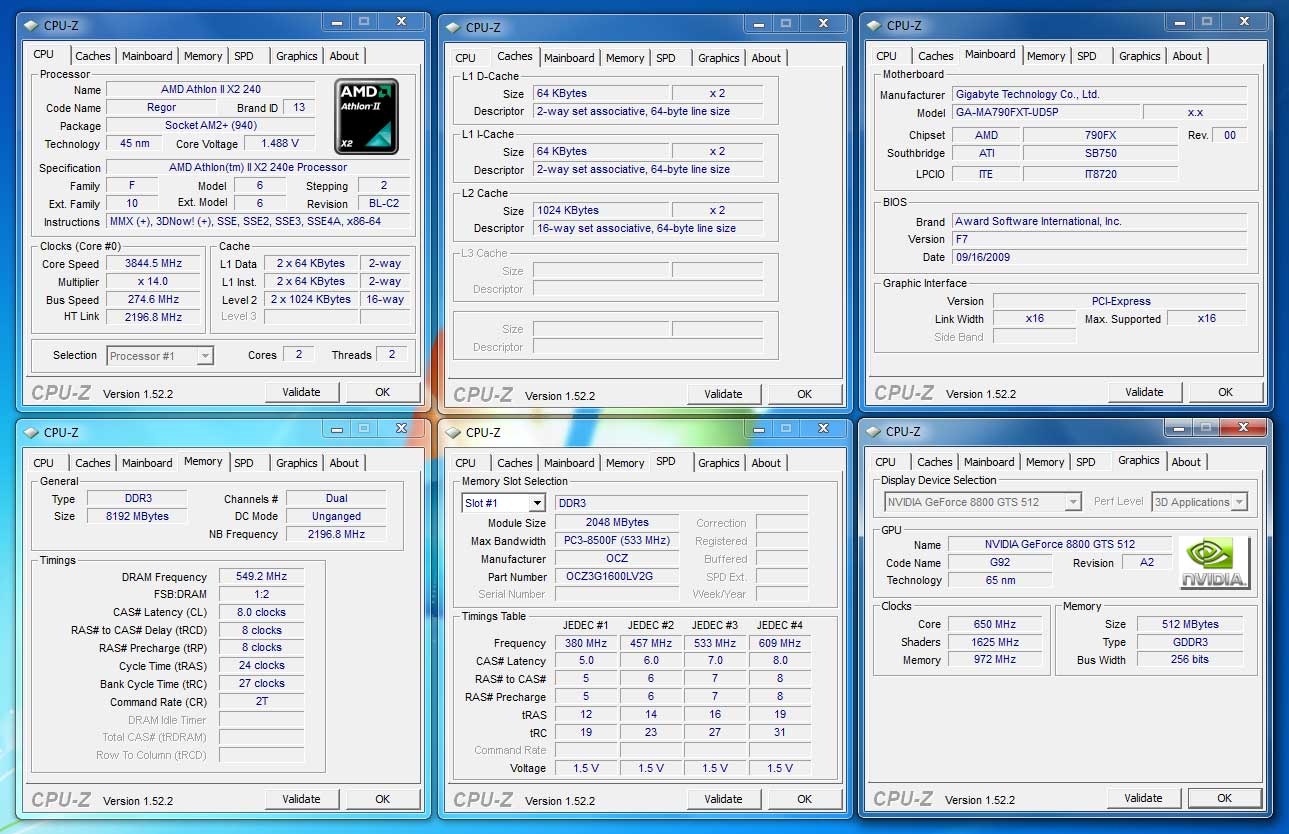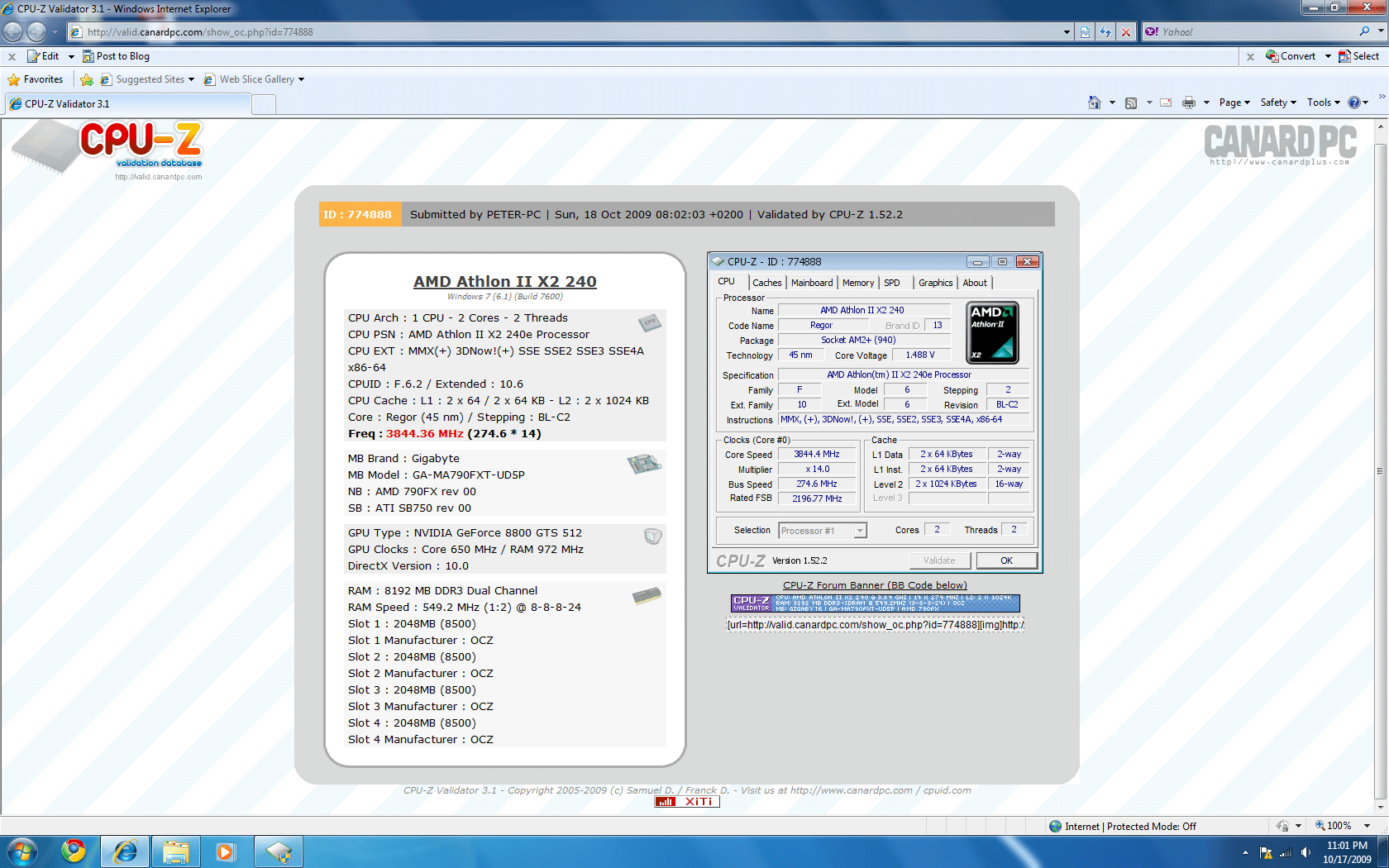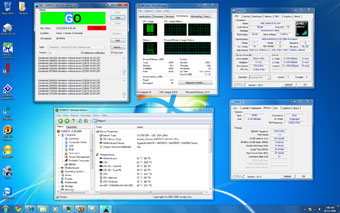AMD’s new relase of the Athlon II X2 240e Processor brings a new inexpensive dual-core chip to the stores. Its low 45W TDP rating brings lower temperatures and much lower power consumption that is perfect for a any HTPC setup.
Introduction
AMD has been slamming out new processors in the past years, tweaking and making their older processors even better and faster. With the launch of AMD’s new Athlon II X2 240e processor, this is not an exception. The new AMD Athlon II X2 240e processor has been redesigned for those seeking very cool, and low power PCs. The new 240e are perfect for Home Theatre PCs, and other general applications like surfing the web, listening to music, and keeping up with friends and family. There is no doubt a processor that will run cool even with the quietest and lowest RPM fans on the market.
This is not all however, the AMD Athlon II X2 240e processors have been designed to work optimaly on some of the new motherboards out there, like the Gigabyte GA-MA790FXT-UD5P motherboard, which we are also taking a look at in this review. The GA-MA790FXT-UD5P motherboard has been built on the 790FX Chipset and can support up to the AM3 socket processors. It has been designed to work with 1600MHz DDR3 memory, however the 240e is built to work properly with 1066MHz memory.
The AMD Athlon 240e is running for $77 USD as of the release date. The Gigabyte GA-MA790FXT-UD5P however is running for $180 USD, which is a very reasonable price for a high overclocking and stable board. Without any further ado lets dig into this and see what this little chip and the Gigabyte motherboard can do compared to some high end processors currently on the market.
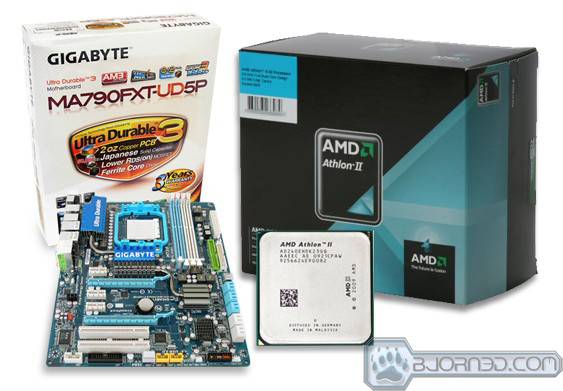
| CPU Name | Cores | Clock | L2/L3 Cache | HT Bus | Socket | TDP | Price |
| AMD Phenom II X4 965 BE | 4 | 3.4GHz | 2+6MB | 4000MHz | AM3 | 140W | $179 |
| AMD Phenom II X4 955 BE | 4 | 3.2GHz | 2+6MB | 4000MHz | AM3 | 125W | $165 |
| AMD Phenom II X4 945 | 4 | 3.0GHz | 2+6MB | 4000MHz | AM3 | 125W | $159 |
| AMD Phenom II X4 925 | 4 | 2.8GHz | 2+6MB | 4000MHz | AM3 | 95W | $139 |
| AMD Phenom II X4 910e | 4 | 2.6GHz | 2+6MB | 4000MHz | AM3 | 65W | $169 |
| AMD Phenom II X4 905e | 4 | 2.5GHz | 2+6MB | 4000MHz | AM3 | 65W | $175 |
| AMD Phenom II X4 810 | 4 | 2.6GHz | 2+4MB | 4000MHz | AM3 | 95W | $139 |
| AMD Phenom II X3 720BE | 3 | 2.8GHz | 1.5+6MB | 4000MHz | AM3 | 95W | $104 |
| AMD Phenom II X3 710 | 3 | 2.6GHz | 1.5+6MB | 4000MHz | AM3 | 95W | $99 |
| AMD Phenom II X3 705e | 3 | 2.5GHz | 1.5+6MB | 4000MHz | AM3 | 65W | $119 |
| AMD Phenom II X2 555 | 2 | 3.2GHz | 1+6MB | 4000MHz | AM3 | 80W | $99 |
| AMD Phenom II X2 550 | 2 | 3.1GHz | 1+6MB | 4000MHz | AM3 | 80W | $91 |
| AMD Athlon II X4 635 | 4 | 2.9GHz | 2MB | 4000MHz | AM3 | 95W | $120 |
| AMD Athlon II X4 630 | 4 | 2.8GHz | 2MB | 4000MHz | AM3 | 95W | $102 |
| AMD Athlon II X4 620 | 4 | 2.6GHz | 2MB | 4000MHz | AM3 | 95W | $99 |
| AMD Athlon II X3 440 | 3 | 3.0GHz | 1.5MB | 4000MHz | AM3 | 95W | $84 |
| AMD Athlon II X3 435 | 3 | 2.9GHz | 1.5MB | 4000MHz | AM3 | 95W | $75 |
| AMD Athlon II X3 425 | 3 | 2.7GHz | 1.5MB | 4000MHz | AM3 | 95W | $72 |
| AMD Athlon II X2 255 | 2 | 3.1GHz | 2MB | 4000MHz | AM3 | 65W | $75 |
| AMD Athlon II X2 250 | 2 | 3.0GHz | 2MB | 4000MHz | AM3 | 65W | $65 |
| AMD Athlon II X2 245 | 2 | 2.9GHz | 2MB | 4000MHz | AM3 | 65W | $61 |
| AMD Athlon II X2 240 | 2 | 2.8GHz | 2MB | 4000MHz | AM3 | 65W | $53 |
Features
AMD Athlon II X2 240e Processor
- New low-power 45W processor
- Perfect for mini towers, small-form-factor PCs, ultra-small-form-factor PCs, and all-in-ones)
- 45nm processor at 45W with exceptional low temperatures
- Support for DDR2 and DDR3 1066Mhz memory
- Cool ‘n’ Quiet
Gigabyte GA-MA790FXT-UD5P
- Ultra Durable 3 Technology with copper cooled quality for lower working temperature
- Revolution energy saving design with Easy Energy Saver technology
- Supports socket AM3 45nm AMD Phenom II series processors
- Advanced 8+2 power phase design for 45nm CPU highly efficiency support
- Dual Channel DDR3 1666+ for remarkable system performance
- 2 PCI-E 2.0 x16 interface with ATI CrossFireX support for ultimate graphics performance
- 2 Gigabit Ethernet LAN with Teaming functionality
- Power/reset/Clr CMOS onboard button for power users
- Blu-ray playback supported by high quality 106dB SNR ALC889A HD audio
- Supports Dolby Home Theater audio to enjoy a rich surround sound experience
- Patented DualBIOS with dual hardware BIOS protection
Specifications
AMD Athlon II X2 240e Processor
| Specifications | AMD Athlon II X2 240e |
|---|---|
| Model Number & Core Frequency |
X2 240e / 2.8GHz |
| OPN |
AD240EHDK23GQ |
| L1 Cache Sizes |
64K of L1 instruction and 64K of L1 data cache per core (256KB total L1 per processor) |
| L2 Cache Sizes |
1MB of L2 data cache per core (2MB total L2 per processor) |
| Memory Controller Type |
Integrated 128-bit wide memory controller |
| Memory Controller Speed |
2.0GHz with Dual Dynamic Power Management |
| Types of Memory Supported |
Support for unregistered DIMMs up to PC2-8500 (DDR2-1066MHz) -AND- PC3-8500 (DDR3-1066MHz) |
| HyperTransport 3.0 Specification |
One 16-bit/16-bit link @ up to 4.0GHz full duplex (2.0GHz x2) |
| Total Processor-to-System Bandwidth |
Up to 33.1GB/s bandwidth |
| Packaging |
Socket AM3 938-pin organic micro pin grid array (micro-PGA) |
| Fab location |
GLOBALFOUNDRIES Fab 1 Module 1 |
| Process Technology |
45-nanometer DSL SOI (silicon-on-insulator) technology |
| Approximate Die Size |
117.5 mm2 |
| Approximate Transistor count |
~ 234 million |
| Max Temp |
72 degrees Celsius |
| Nominal Voltage |
.775 – 1.35V |
| Max TDP |
45 Watts |
Even though the Max Temperature specified is 72 degrees, at 45 Watts, this will not be a problem at all. With a proper air circulation, and good CPU cooling, the CPU shouldn’t go any higher than 50C under load. During our testing the CPU barely went higher or if even 40C under load. This gives a huge amount of head room for people worried about heat.
Gigabyte GA-MA790FXT-UD5P
| Specifications | Gigabyte GA-MA790FXT-UD5P |
|---|---|
| CPU |
Support for Socket AM3 processors: AMD Phenom™ II X4 processor / AMD Phenom™ II X3 processor |
| Front Side Bus |
5200 MT/s |
| Chipset |
|
| Memory |
|
| Audio |
|
| LAN |
|
| Expansion Slots |
|
| Storage Interface |
South Bridge:
GIGABYTE SATA2 chip:
ITE 8720 chip:
|
| IEEE 1394 |
T.I. TSB43AB23 chip
|
| USB |
Integrated in the South Bridge
|
| Internal I/O Connectors |
|
| Back Panel Connectors |
|
| I/O Controller |
ITE IT8720 chip |
| H/W Monitoring |
System voltage detection
|
| BIOS |
|
| Unique Features |
|
| Bundle Software |
Norton Internet Security (OEM version) |
| Operating System |
Support for Microsoft Windows Vista/ XP |
| Form Factor |
ATX Form Factor; 30.5cm x 24.4cm |
One thing to notice in these specifications is that while the motherboard supports up to 1600MHz memory speed, there is no guarantee that your memory is going to work at the given speed. For example, I have a OCZ 1600MHz DDR3 kit at home, and if I use this memory with the AMD Athlon II X2 240e processor and I keep it at 1600MHz then my system is unstable and will randomly crash. When I go into the AMD specification range, which is 1066MHz for the memory then the system is completely stable.
A Closer Look
AMD Athlon II X2 240e
Gigabyte GA-MA790FXT-UD5P
Click Image For a Larger One
This is the boxing laid down. We can see that the side of the box pretty much has the same information as the front. Enough for the person picking a board at a store to see what each motherboard supports.
Click Image For a Larger One
Click Image For a Larger One
And finally, here are the accessories that come with the motherboard. We can see a Motherboard driver disk, User’s Manual, Quick Installation Guide, a sticker, One IDE cable, Four SATA 3Gb/s cables, One SATA bracket, and I/O Shield Plate, Two external SATA cables, and external power cable.
Cpu-z
Stock
Here is a screen shot taken of CPU-Z while it was running. The system was at its stock settings.
Click Image for a Larger One
Overclocked
On this picture however, we see the overclocked settings for the CPU.
Click Image for a Larger One
OVERCLOCKING
Before we continue on how we got the AMD Athlon II X2 240e processor stable at 3.85GHz, let’s take a look at the CPU-Z validation as a proof.
Click Image for a Larger One
Here is the stress test that we have done to make sure that the AMD Athlon II X2 240e processor was stable at 3.85GHz.
bios
testing & methodology
Setting Up The System For Benchmarking
All the tests we do, no matter on what hardware it is, we run each test a total of at least three times minimum, some tests we run more than 3 times. We average the total of all the tests from each benchmark then report the average here.
The OS we use is Windows 7 Professional with all patches and updates applied. We also use the latest drivers, BIOS and anything else available for the motherboards, video cards, and any devices attached to the computer. We don’t disable a bunch of background tasks or particularly tweak the OS or system for bigger numbers. We do turn off drive indexing and daily defragging. We also turn off Prefetch and Superfetch. This is not an attempt to produce bigger benchmark numbers. Drive indexing and defragging can interfere with testing in that one test might occur without defragging going on and the next test defragging might be active, the same thing goes for drive indexing. We can’t control when defragging and indexing occur precisely enough to guarantee that they won’t interfere with testing, so we turn them off.
Prefetch tries to predict what you will load the next time you boot the machine. We disable it because we want to know how the program runs without any of the files being cached, otherwise each test run we’d have to clear pre-fetch to get accurate numbers. Lastly we disable Superfetch, Superfetch loads often used programs into memory and is one of the reasons people consider Vista to be such a memory hog. Vista fills the memory in an attempt to predict what you will load. Having one test run with files cached, and another test run with the files being un-cached would result in skewed numbers. Again since we can’t control it we turn it off. Other than those 4 things which can potentially interfere with benchmarking, and do so out of our control, we leave everything else running.
Measuring Temperature And Overall Power Consumption
Measuring temperatures and the overall power consumption of a computer system can get quite interesting since there are plenty of ways of doing it. First of all lets start with measuring temperature. To measure the CPU and temperatures, we used Everest Ultimate.
To measure the overall wattage used by the computer system we used a Craftsman 400A AC/DC Clamp Meter. We attached the clamp straight to the wall outlet with a special divider to measure the overall Wattage being used accurately. The results were precisely recorded in a word document.
Test Rig
The following system(s) were used to benchmark the different CPUs.
|
Test Rig
|
|||
|
Case
|
Cooler Master Stacker 830 SE
|
Thermaltake Lanbox Lite
|
|
|
CPU
|
Intel Core I7 920 Extreme 2.66GHz
Intel Core 2 Quad Q9400 2.66GHz
Intel Core 2 Quad Q6600 2.4GHz
|
AMD Athlon II X2 240e 2.8GHz
|
AMD Phenom X4 9350e 2.0GHz
|
|
Motherboard
|
ASUS P6T SE X58 Motherboard
ASUS P5E3 WS Professional X38 Motherboard
|
Gigabyte GA-MA790FXT-UD5P
|
Gigabyte MA78GM-S2H
|
|
Ram
|
OCZ DDR3-12800 1600Mhz 12GB Kit
OCZ DDR3-12800 @ 1600Mhz 8GB Kit
|
OCZ DDR3-12800 @ 1066Mhz 8GB Kit
|
OCZ DDR2-8500 @ 1066Mhz 4GB Kit
|
|
CPU Cooler
|
Cooler Master Aquagate Max Water Cooling System (LGA775)
|
Noctua NH-U12P Heatsink with 2x Noctua NF-P12 Fans from AcousticPC.com
|
|
|
Hard Drives
|
2x Western Digital RAID Edition 3 1TB Hard Drives
2x Seagate Barracude 7200.11 500GB Hard Drives
|
Western Digital Blue 640GB SATAII Hard Drive
|
|
|
Optical
|
Sony DVD R/W
|
||
|
GPU
|
XFX GeForce 8800GTS G92 512MB Alpha Dog Edition
|
||
|
Case Fans
|
2x Noctua NF-P12 120mm Fans – Side
1x Noctua NF-P12 120mm Fan – Front
1x Noctua NF-P12 120mm Fan – Back
1x Noctua NF-P12 120mm Fan – Top
|
1x 90mm Blue-LED Front Fan
2x 60mm Back Fans
|
|
|
Additional Fans
|
2x Noctua NF-R8 80mm Fans – Video Card
1x Cool-It Memory Fan Cooler
|
||
|
PSU
|
Sapphire Pure 1250 Watt Modular Power Supply
|
Enermax 550 Watt Power Supply
|
|
|
Mouse
|
Logitech G5
|
||
|
Keyboard
|
Logitech G15
|
||
The different systems were put together to try to get as close to each other as possible, this is why we tried to use as many of the same hardware as possible. This will allow us to get accurate wattage readings when measuring for power consumption. Some parts might differ like the cooling used on the processors, and this is because the power consumption and the temperature readings were gathered over time instead of retesting all the processors with one CPU cooler.
Test Suite
|
Benchmarks |
|
3DMark Vantage |
|
PCMark Vantage |
|
SiSoftware Sandra 2009 SP1 |
|
Everest Ultimate Edition |
|
SuperPi |
|
Cinebench R10 64-Bit |
|
Crysis Warhead |
3DMark Vantage

For complete information on 3DMark Vantage Please follow this Link:
www.futuremark.com/benchmarks/3dmarkvantage/features/
The newest video benchmark from the gang at Futuremark. This utility is still a synthetic benchmark, but one that more closely reflects real world gaming performance. While it is not a perfect replacement for actual game benchmarks, it has its uses. We tested our cards at the ‘Performance’ setting.
Currently, there is a lot of controversy surrounding NVIDIA’s use of a PhysX driver for its 9800 GTX and GTX 200 series cards, thereby putting the ATI brand at a disadvantage. Whereby installing the PyhsX driver, 3DMark Vantage uses the GPU to perform PhysX calculations during a CPU test, and this is where things get a bit gray. If you look at the Driver Approval Policy for 3DMark Vantage it states; “Based on the specification and design of the CPU tests, GPU make, type or driver version may not have a significant effect on the results of either of the CPU tests as indicated in Section 7.3 of the 3DMark Vantage specification and white paper.” Did NVIDIA cheat by having the GPU handle the PhysX calculations or are they perfectly within their right since they own Ageia and all their IP? I think this point will quickly become moot once Futuremark releases an update to the test.
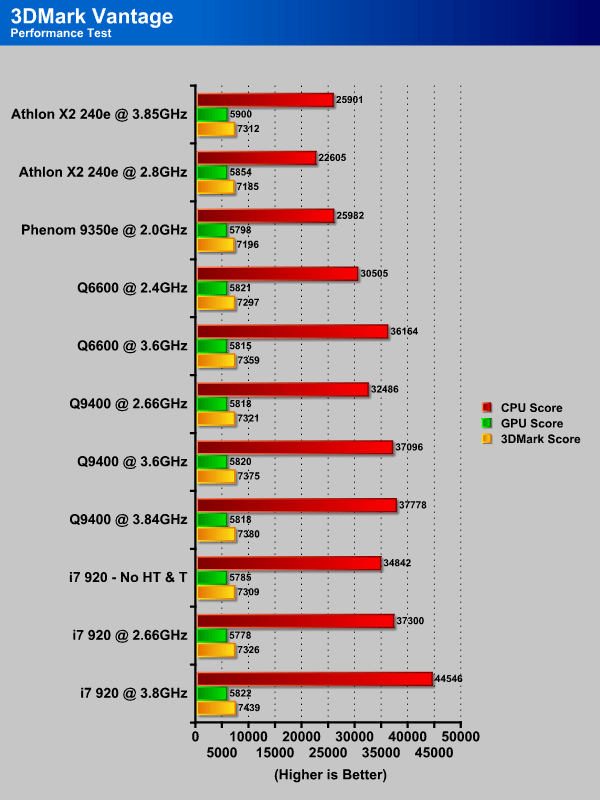
In these tests we do not see too much flactuation in the GPU and 3DMark Scores much, however we can clearly see the difference in CPU speed across the tested processors. PhysX was enabled for all the tests therefore the GPU PhysX calculations are incorporated in the CPU tests, but since we used the same video card for all the processors, this shouldn’t change the results too much. On the other hand, we can see that the 240e came close to beating the Phenom 9350e. With a bit more tweaking and possibly if we could get higher in the clock speed of the 240e, we could beat the 9350e, but I don’t think that we could beat any of the Intel Quad-Core processors.
pcmark vantage
For complete information on 3DMark Vantage Please follow this Link:
http://www.futuremark.com/benchmarks/pcmarkvantage/features/
PCMark Vantage is a PC benchmark suite designed for Windows Vista offering one-click simplicity for casual users and detailed, professional grade testing for industry, press and enthusiasts.
A PCMark score is a measure of your computer’s performance across a variety of common tasks such as viewing and editing photos, video, music and other media, gaming, communications, productivity and security.
From desktops and laptops to workstations and gaming rigs, by comparing your PCMark Vantage score with other similar systems you can find the hardware and software bottlenecks that stop you getting more from your PC.

In these results, we can pretty much see that the 240e has fallen back from the rest of the processors except the AMD Phenom 9350e, with which it is competing very well. This is expected due to comparing Quad-Core processors with the AMD Athlon X2 240e Dual-Core chip. Overall, it seems that the 240e is running pretty close to the other processors in the Music Suite test, which makes this processor promising for users not interested in gaming and other 3D Rendering applications.
Sisoft Sandra 2009 SP1
“SiSoftware Sandra (the System Analyser, Diagnostic and Reporting Assistant) is an information & diagnostic utility. It should provide most of the information (including undocumented) you need to know about your hardware, software and other devices whether hardware or software. It works along the lines of other Windows utilities, however it tries to go beyond them and show you more of what’s really going on. Giving the user the ability to draw comparisons at both a high and low-level. You can get information about the CPU, chipset, video adapter, ports, printers, sound card, memory, network, Windows internals, AGP, PCI, PCI-X, PCIe (PCI Express), database, USB, USB2, 1394/Firewire, etc.”
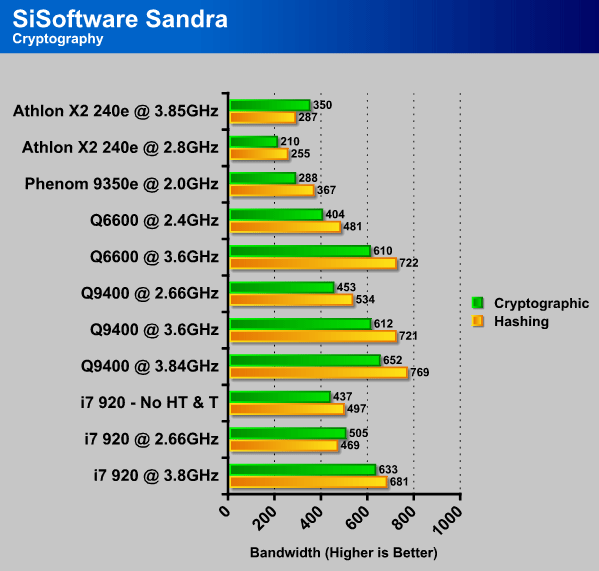
This benchmark performs tests on Encryption and Decryption of files. For computer systems that encrypt and decrypt many files a processor with a higher score will perform better in that task. We can see that the stock 240e could not keep up with the other Quad-Core processors, which is totally understandable, but it was very close to beating the Phenom 9350e when it was overclocked.
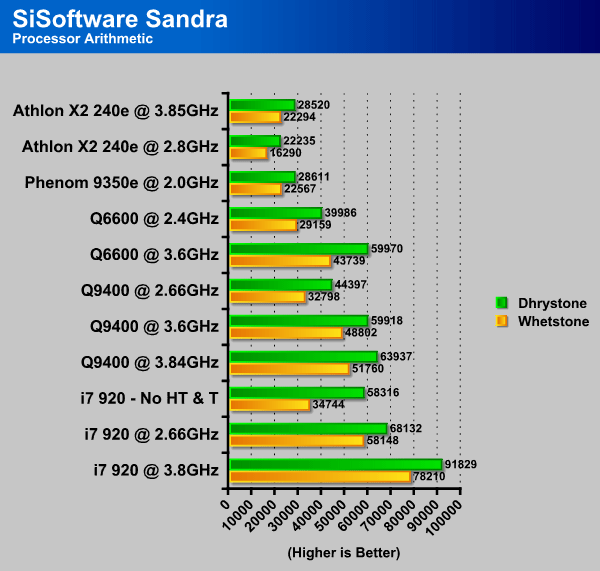
This tests shows how your processor handles arithmetic and floating point instructions. The higher the score the better. Since this processor is a dual-core instead of all the rest of the processors being Quad-Core, these tests are not quite well comparable since it would be comparing apples to bananas, however it can give a nice understanding about how these processors differ from each other.

This test involves the generation of Mandelbrot Set fractals that are used to realistically describe and generate natural objects such as mountains or clouds. By using various multi-media extensions better performance is achieved.
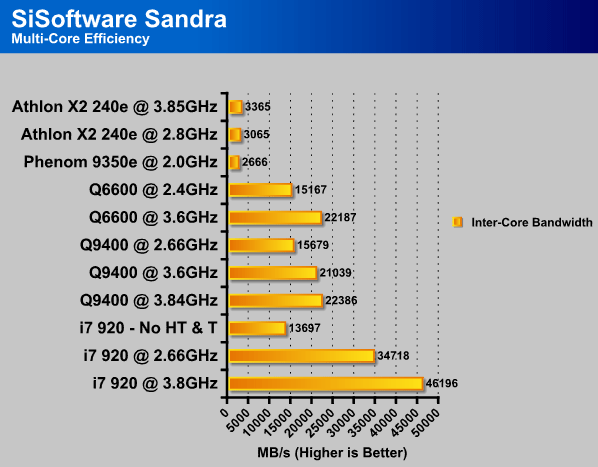
This shows how efficient the processor cores and their inter-connects are in comparison to other types to other typical processors. Unfortunately all the AMD processors including the X2 240e have dramatically failed compared to the Intel processors.
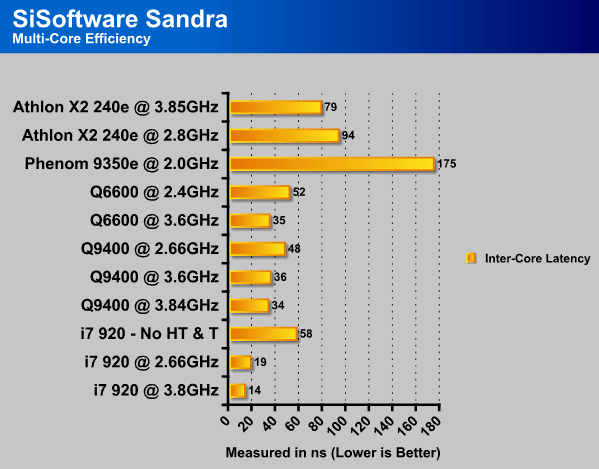
And finally in this one we can see that the time it takes to get certain things complete takes a longer time on the AMD processors do to their slower latency.
everest ultimate Edition
EVEREST Ultimate Edition is an industry leading system diagnostics and benchmarking solution for enthusiasts PC users, based on the award-winning EVEREST Technology. During system optimizations and tweaking it provides essential system and overclock information, advanced hardware monitoring and diagnostics capabilities to check the effects of the applied settings. CPU, FPU and memory benchmarks are available to measure the actual system performance and compare it to previous states or other systems. Furthermore, complete software, operating system and security information makes EVEREST Ultimate Edition a comprehensive system diagnostics tool that offers a total of 100 pages of information about your PC.
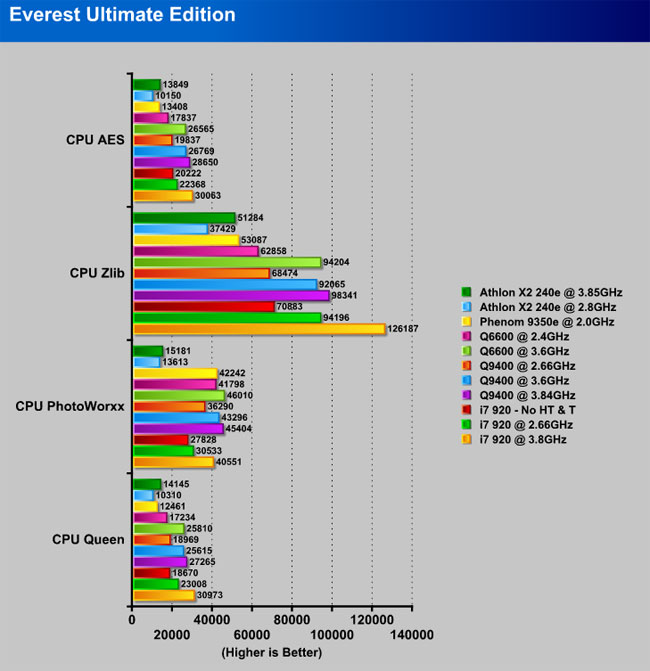
This test is quite interesting. We can clearly notice that the biggest difference in performance across the processors was in the CPU Zlib test. This integer benchmark measures combined CPU and memory subsystem performance through the public ZLib compression library.
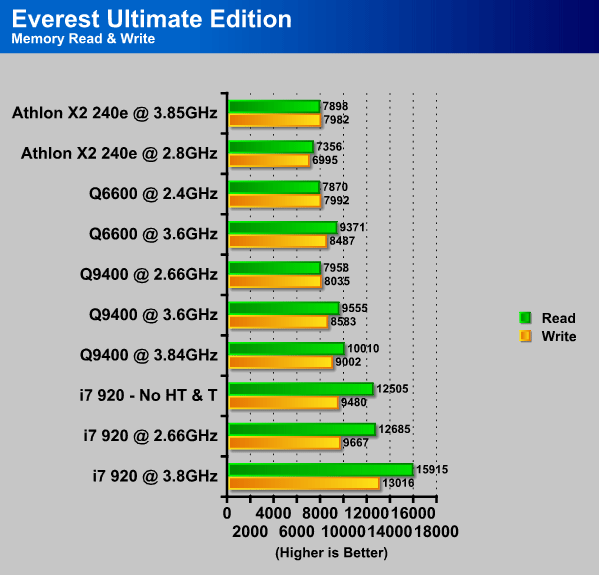
Finally from the Everest benchmarks, we can see how the memory transfer speeds look like across the tested processors. We can see that till Dual-Channel memories were used, with any processor, the tests were very close to each other. When Triple-Channel memories were introduced in the Core i7 family, the memory speeds went up dramatically.
superpi
Super PI is a software that calculates the PI digits to thousands and millions of digits. This software is mainly used for testing the speed of your CPU calculation. Because of this we did a 4 Million digit calculation.
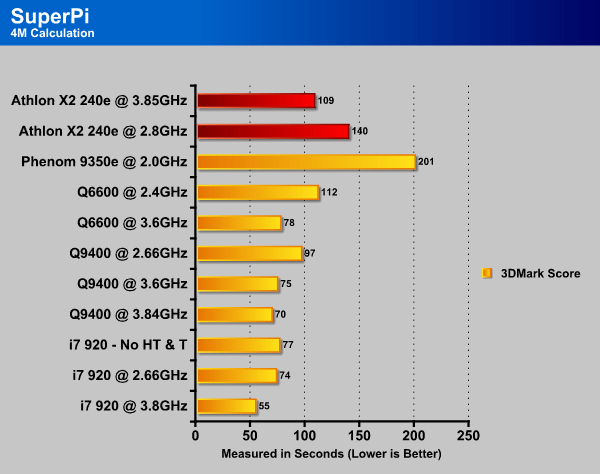
We saw a significant improvement on the X2 240e when we ran SuperPi. The X2 240e running at 3.85GHz finished computing 4 million digits barely by 3 seconds less than the Intel Q6600 at stock speeds. The X2 240e at stock had a big advantage over the Phenom 9350e as well. In the SuperPi tests, core speed is more important that the number of cores. Depending on the application, the X2 240e could perform better than the Phenom 9350e or the some of the Intel Quad-Core processors.
cinebench R10 64-bit
CINEBENCH is a real-world test suite that assesses your computer’s performance capabilities. MAXON CINEBENCH is based on MAXON’s award-winning animation software, CINEMA 4D, which is used extensively by studios and production houses worldwide for 3D content creation. MAXON software has been used in blockbuster movies such as Spider-Man, Star Wars, The Chronicles of Narnia and many more. MAXON CINEBENCH runs several tests on your computer to measure the performance of the main processor and the graphics card under real world circumstances. The benchmark application makes use of up to 16 CPUs or CPU cores and is available for Windows (32-bit and 64-Bit) and Macintosh (PPC and Intel-based). The resulting values among different operating systems are 100% comparable and therefore very useful with regard to purchasing decision-making. It can also be used as a marketing tool for hardware vendors or simply to compare hardware among colleagues or friends.
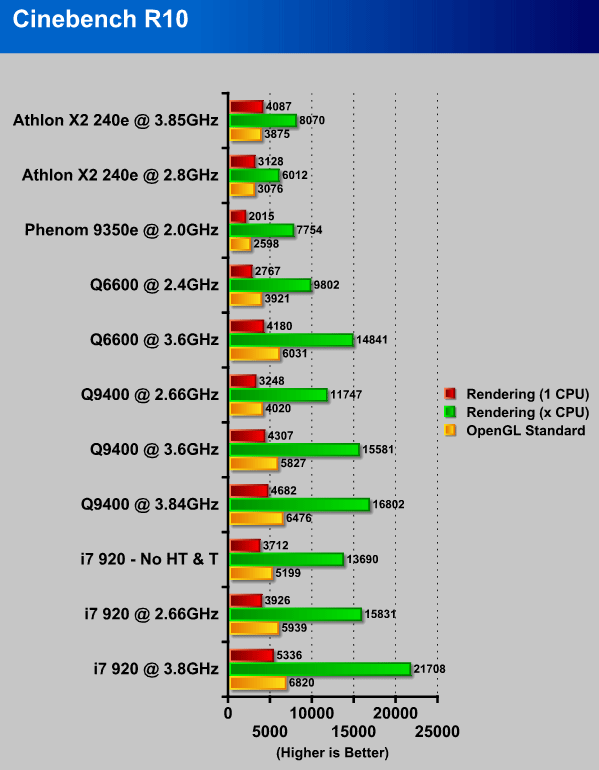
As a past user of Cinema 4D, a 3D application that is used to create some of the most stunning animation currently seen in advertisements and movies, I know how important it is to have a powerful processor for rendering. On these test the X2 was obviously the weakest from all the processors, which is why this processor is not made for 3D rendering, but instead for smaller PCs that can be used for HDTVs and other smaller systems.
CRYSIS WARHEAD

Crysis Warhead is the much anticipated sequel of Crysis, featuring an updated CryENGINE™ 2 with better optimization. It was one of the most anticipated titles of 2008.
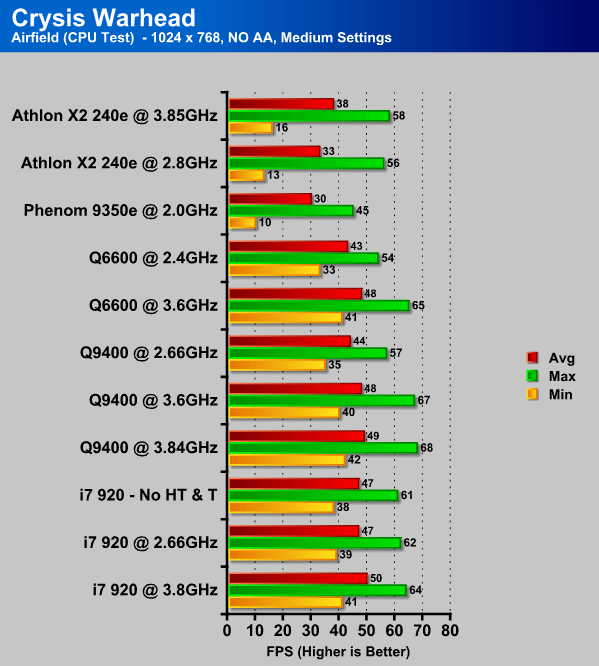
And finally this is the last benchmark for the CPU. We can see that the clock speed plays a big role in FPS in games, and if we take a look at only the AMD processors it is visible that the higher the clock speed is on the processor the more FPS we are getting. You don’t need a Quad-Core processor to achieve nice FPS, but unfortunately the 240e cannot keep up with the requirements of Crysis since the game becomes unplayable when we reach low FPSs like 10, 13, and 16.
TEMPERATURES

Temperature is one of the parts that some current manufacturers don’t really pay attention too. It is time to come out with new technologies allowing us to further develop our chips and maintain low temperatures. This is why we at Bjorn3D pay close attention to making sure that each product is measured and reported with accurate temperature readings.

While the X2 240e did perform fairly well compared to its Quad-Core competition, one of the most exciting parts of the 240e is its temperature. All the other processors, except the Phenom 9350e was water cooled. The Athlon X2 240e was cooled with Noctua’s NH-U12P cooler with 2x Noctua NF-P12 fans. Even seeing that there was water cooling cooling the Intel processors, and air cooling the AMD processors, I am very surprised with the temperatures. The 240e kept the lowest Load temperatures at all times.
POWER CONSUMPTION

Temperatures are not the only thing that need to be improved on. Power consumption is another big topic to take a look at. Current technology allows us to create newer and better products, but this makes new hardware more power hungry. Let’s take a look how these hardware compare to each other.
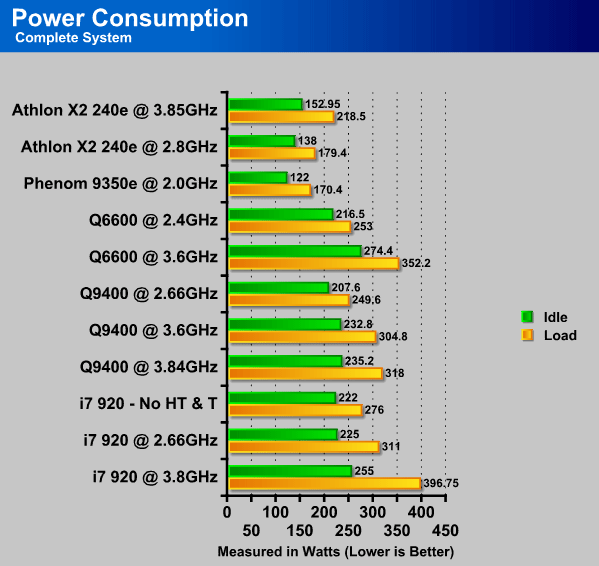
To conclude with all the tests, we have measured the overall power consumption of the processors. We tried to keep all the systems as close as possible and reuse all the hardware possible to maintain a fair reading of the power consumption. The power consumption of the new X2 240e processor is very low, if we take a look at all the other processors. The phenom 9350e had a lower power consumption perhaps because of the lower amount of fans in the system and lower end motherboard.
conclusion
The new AMD Athlon II X2 240e processor is very promising for everyday work. We didn’t have any problems with the processor except a memory issue that was resolved by down clocking our OCZ 1600Mhz DDR3 memory to 1066Mhz. Other than that the X2 240e performed exceptionally in both temperatures as well as power consumption. This processor also works very well with overclocking, which means that overclockers can enjoy messing with this CPU without worrying much about making their processor unstable. When the X2 240e was overclocked to 3.85GHz temperature and power consumption was not an issue either, which is why I would recommend this processor for anybody who is looking for low temperature and low power consumption processor for their workstation or HTPC.
The Gigabyte GA-MA790FXT-UD5P on the other hand did very exceptionally as well. Its overclocking potential allowed us to overclock the AMD Athlon II X2 240e processor to 3.85GHz. It is nice to see that the GA-MA790FXT-UD5P can also support the new AMD processors on the market. We had to update the BIOS to the latest revision to get everything stable, but this is acceptable since the Athlon II X2 240e is a new processor. The motherboard ran really cool, and we never had any problems with it.
Over time we would like to see more hardware companies making a jump towards lower power consumption and lower temperature standard. The moment has come to make a change and develope a new technology that will allow us to do this. To be honest with you, I am quite dissapointed in the fact that companies keep making powerful chips, while not taking heat and power into consideration. If we can develope a new technology that will allow us to use less power and produce less heat on more powerful chips, then that would be exceptional. Thankfully, AMD has done this with the Athlon II X2 240e processor, and we are hoping other companies will do too.
| OUR VERDICT: AMD Athlon II X2 240e Processor | ||||||||||||||||||
|
||||||||||||||||||
| Summary: Overall the AMD Athlon II X2 240e processor is not for everybody. This processor comes very handy for Home Theater PCs and other small form factor PCs. We recommend the X2 240e to anybody who is looking into only using the computer for casual applications, and nothing too extra like Video/Photo Editing, and Rendering. The AMD Athlon II X2 240e processor on the other hand is very affordable and has good performance to price ratio, which is why we are awarding it two Awards: Bjorn3D’s Seal of Approval Award, and Bjorn3D’s Best Bang for the Buck Award! |
| OUR VERDICT: Gigabyte GA-MA790FXT-UD5P Motherboard | ||||||||||||||||||
|
||||||||||||||||||
| Summary: The Gigabyte GA-MA790FXT-UD5P motherboard is very well designed with excellent features and overclocking potential. Its support for the latest and best AMD processors gives this board a big advantage over other manufacturers boards. Overall, the Gigabyte GA-MA790FXT-UD5P motherboard was a pure joy to work with, which is why this motherboard scores a total of 8.5 points which earns it a Bjorn3D Seal of Approval Award! |
| CPU Name | Cores | Clock | L2/L3 Cache | HT Bus | Socket | TDP | Price |
| AMD Phenom II X4 965 BE | 4 | 3.4GHz | 2+6MB | 4000MHz | AM3 | 140W | $179 |
| AMD Phenom II X4 955 BE | 4 | 3.2GHz | 2+6MB | 4000MHz | AM3 | 125W | $165 |
| AMD Phenom II X4 945 | 4 | 3.0GHz | 2+6MB | 4000MHz | AM3 | 125W | $159 |
| AMD Phenom II X4 925 | 4 | 2.8GHz | 2+6MB | 4000MHz | AM3 | 95W | $139 |
| AMD Phenom II X4 910e | 4 | 2.6GHz | 2+6MB | 4000MHz | AM3 | 65W | $169 |
| AMD Phenom II X4 905e | 4 | 2.5GHz | 2+6MB | 4000MHz | AM3 | 65W | $175 |
| AMD Phenom II X4 810 | 4 | 2.6GHz | 2+4MB | 4000MHz | AM3 | 95W | $139 |
| AMD Phenom II X3 720BE | 3 | 2.8GHz | 1.5+6MB | 4000MHz | AM3 | 95W | $104 |
| AMD Phenom II X3 710 | 3 | 2.6GHz | 1.5+6MB | 4000MHz | AM3 | 95W | $99 |
| AMD Phenom II X3 705e | 3 | 2.5GHz | 1.5+6MB | 4000MHz | AM3 | 65W | $119 |
| AMD Phenom II X2 555 | 2 | 3.2GHz | 1+6MB | 4000MHz | AM3 | 80W | $99 |
| AMD Phenom II X2 550 | 2 | 3.1GHz | 1+6MB | 4000MHz | AM3 | 80W | $91 |
| AMD Athlon II X4 635 | 4 | 2.9GHz | 2MB | 4000MHz | AM3 | 95W | $120 |
| AMD Athlon II X4 630 | 4 | 2.8GHz | 2MB | 4000MHz | AM3 | 95W | $102 |
| AMD Athlon II X4 620 | 4 | 2.6GHz | 2MB | 4000MHz | AM3 | 95W | $99 |
| AMD Athlon II X3 440 | 3 | 3.0GHz | 1.5MB | 4000MHz | AM3 | 95W | $84 |
| AMD Athlon II X3 435 | 3 | 2.9GHz | 1.5MB | 4000MHz | AM3 | 95W | $75 |
| AMD Athlon II X3 425 | 3 | 2.7GHz | 1.5MB | 4000MHz | AM3 | 95W | $72 |
| AMD Athlon II X2 255 | 2 | 3.1GHz | 2MB | 4000MHz | AM3 | 65W | $75 |
| AMD Athlon II X2 250 | 2 | 3.0GHz | 2MB | 4000MHz | AM3 | 65W | $65 |
| AMD Athlon II X2 245 | 2 | 2.9GHz | 2MB | 4000MHz | AM3 | 65W | $61 |
| AMD Athlon II X2 240 | 2 | 2.8GHz | 2MB | 4000MHz | AM3 | 65W | $53 |
 Bjorn3D.com Bjorn3d.com – Satisfying Your Daily Tech Cravings Since 1996
Bjorn3D.com Bjorn3d.com – Satisfying Your Daily Tech Cravings Since 1996



















